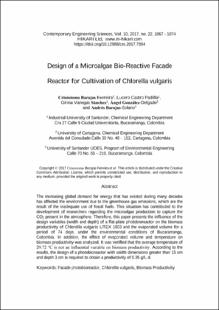Design of a microalgae bio-reactive facade reactor for cultivation of Chlorella vulgaris
Artículo de revista
2017-11-14
Contemporary Engineering Sciences
Bulgaria
The increasing global demand for energy that has existed during many decades
has affected the environment due to the greenhouse gas emissions, which are the
result of the inadequate use of fossil fuels. This situation has contributed to the
development of researchers regarding the microalgae production to capture the
CO2 present in the atmosphere. Therefore, this paper presents the influence of the
design variables (width and depth) of a flat-plate photobioreactor on the biomass
productivity of Chlorella vulgaris UTEX 1803 and the evaporated volume for a
period of 74 days, under the environmental conditions of Bucaramanga,
Colombia. In addition, the effect of evaporated volume and temperature on
biomass productivity was analyzed. It was verified that the average temperature of
29.72 °C is not an influential variable on biomass productivity. According to the
results, the design of a photobioreactor with width dimensions greater than 15 cm
and depth 3 cm is required to obtain a productivity of 0.35 g/L d.
- Ambiente y Vida - GIAV [124]
Descripción:
Design of a Microalgae Bio-Reactive Facade Reactor for Cultivation of Chlorella vulgaris.pdf
Título: Design of a Microalgae Bio-Reactive Facade Reactor for Cultivation of Chlorella vulgaris.pdf
Tamaño: 572.2Kb
 PDF
PDF
 LEER EN FLIP
LEER EN FLIP
Título: Design of a Microalgae Bio-Reactive Facade Reactor for Cultivation of Chlorella vulgaris.pdf
Tamaño: 572.2Kb
 PDF
PDF
 LEER EN FLIP
LEER EN FLIP
















